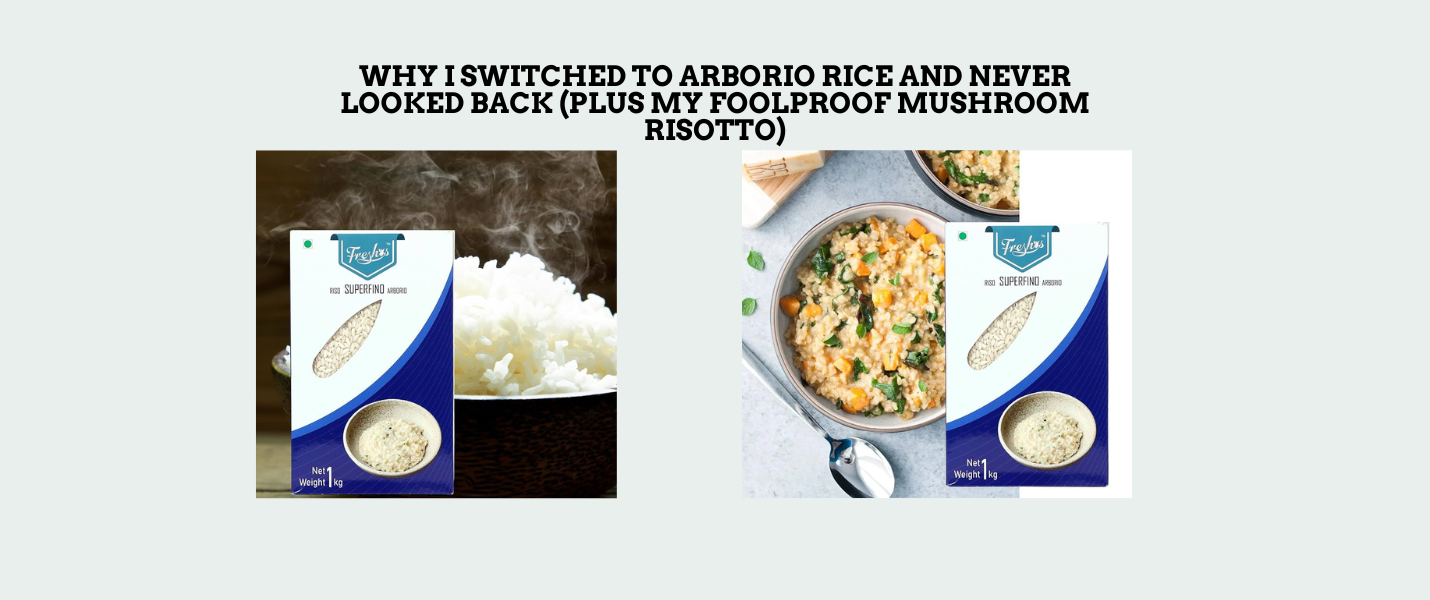

Why I Switched to Arborio Rice and Never Looked Back (Plus My Foolproof Mushroom Risotto)
Table of Contents
- Introduction: The Rice That Changed Everything
- What Makes Arborio Rice So Special?
- Why Did I Make the Switch? My Personal Journey
- 3.1. The Basmati Disappointment
- 3.2. The Economics of Quality
- How to Cook Perfect Risotto: Understanding the Technique
- 4.1. The Science Behind Creamy Risotto
- 4.2. Essential Equipment and Ingredients
- My Foolproof Mushroom Risotto Recipe
- 5.1. Ingredients (Serves 4-6)
- 5.2. Step-by-Step Method
- What Other Dishes Can You Make with Arborio Rice?
- 6.1. Beyond Traditional Risotto
- 6.2. Fusion Applications
- How Does Arborio Rice Compare to Other Varieties?
- 7.1. Comprehensive Rice Comparison Table
- 7.2. Why Substitutes Don't Work
- Professional Tips for Perfect Results Every Time
- 8.1. Temperature and Timing Mastery
- 8.2. Storage and Reheating Strategies
- Common Mistakes and How to Avoid Them
- 9.1. The Biggest Pitfalls
- 9.2. Rescue Techniques
- Why Arborio Rice Is Worth the Investment
- 10.1. Long-term Value Proposition
- 10.2. The Satisfaction Factor
- Where to Buy Quality Arborio Rice in India
- Frequently Asked Questions
- Conclusion: Your Journey to Risotto Mastery Starts Here
Introduction: The Rice That Changed Everything
Three years ago, I was standing in the rice aisle of my local grocery store, overwhelmed by the endless varieties—basmati, jasmine, brown, wild, and then I spotted it: a small, expensive bag labeled "Arborio rice." At ₹800 for 500g, it seemed outrageous compared to my usual ₹150 basmati. But curiosity got the better of me, and I decided to splurge on this mysterious Italian rice that promised to transform my home cooking forever.
The best part? Once you master the basics of how to make risotto, you'll wonder why you ever settled for anything less. Whether you're sourcing premium Arborio rice from trusted suppliers like ChefsPoint or experimenting with Arborio rice recipes beyond the traditional scope, this remarkable grain opens up a world of culinary possibilities that will elevate every meal.
What Makes Arborio Rice So Special?
Arborio rice originated in the Po Valley of northern Italy, specifically in the town of Arborio in Piedmont. This premium Italian rice belongs to the superfino category, representing the highest grade of Italian rice varieties. Unlike regular long-grain rice, Arborio rice features plump, oval-shaped kernels that contain extraordinary levels of amylopectin starch, which creates that signature creamy texture without becoming mushy.
- High starch content: Contains 20% amylopectin, double that of regular rice, creating natural creaminess for perfect risotto recipe results
- Superior absorption: Each grain can absorb up to five times its weight in liquid while maintaining structure, ideal for creamy risotto
- Perfect texture: Delivers the ideal balance of creamy exterior and firm, slightly chewy center that defines authentic Italian rice preparations
- Versatile cooking: Works beautifully in risotto recipes, rice puddings, stuffed vegetables, and innovative fusion dishes
Why Did I Make the Switch? My Personal Journey
The Basmati Disappointment
For years, I attempted to make risotto recipe variations using basmati rice—the results were consistently disappointing. The grains would either turn mushy or remain separate and dry, never achieving that luxurious, creamy risotto consistency I craved. I tried every technique: different liquid ratios, cooking times, and stirring methods. Nothing worked because I was using the wrong foundation for authentic Italian cuisine.
The breakthrough came during a dinner party when a friend brought homemade mushroom risotto made with authentic Arborio rice. One spoonful, and I understood what I'd been missing. The texture was revelatory—simultaneously creamy and firm, with each grain perfectly coated in a silky, restaurant-quality sauce that no Arborio rice substitute could replicate.
- Texture revelation: The First taste of properly made risotto showed me what real creamy risotto consistency meant
- Consistent results: Unlike basmati experiments, Arborio rice delivered perfect risotto recipe results every single time
- Guest impressions: Friends started requesting my risotto specifically, elevating my hosting reputation through authentic Italian rice mastery
- Cooking confidence: Mastering how to make risotto with proper risotto ingredients boosted my overall culinary skills dramatically
How to Cook Perfect Risotto: Understanding the Technique
The Science Behind Creamy Risotto
Making exceptional creamy risotto isn't just about following a risotto recipe—it's about understanding the science behind Arborio rice. The amylopectin starch in this Italian rice needs gentle coaxing through specific temperature control and gradual liquid incorporation. Rush the process, and you'll get gluey mush. Skip the stirring, and you'll end up with separate, chalky grains that no Arborio rice substitute could improve.
The key lies in maintaining the short grain rice at exactly the right temperature while slowly building layers of flavor. Each ladle of warm broth dissolves a bit more starch from the Arborio rice surface, creating that characteristic mantecatura—the creamy risotto consistency that defines perfect Italian cuisine execution.
- Temperature control: Keep Arborio rice simmering gently, never boiling vigorously, for proper risotto recipe success
- Gradual liquid addition: Add warm broth one ladle at a time to Italian rice, stirring until absorbed
- Constant motion: Stirring releases starch gradually from short-grain rice while preventing sticking
- Timing precision: Perfect creamy risotto takes exactly 18-20 minutes from first broth addition to finish
Essential Equipment and Ingredients
Success with risotto ingredients starts with having the right tools and components ready before you begin how to make risotto. Unlike other rice dishes where you can be casual about timing, risotto recipe execution demands your complete attention for 20 minutes straight—there's no pausing to hunt for Arborio rice or equipment.
Your heavy-bottomed pan is crucial for even heat distribution with Italian rice, while a good ladle ensures consistent liquid portions. The broth should be simmering in a separate pot, ready for immediate use with your short grain rice, and all risotto ingredients should be prepped and within arm's reach.
- Heavy-bottomed saucepan: Ensures even heat distribution for Arborio rice and prevents hot spots that could scorch grains
- Warm broth: Keep 1-1.5 liters of quality stock simmering throughout the creamy risotto cooking process
- Sharp knife and cutting board: All vegetables for the risotto recipe must be finely diced for even cooking
- Wooden spoon: Gentle stirring tool that won't break Italian rice grains during the how to make risotto process
My Foolproof Mushroom Risotto Recipe
Ingredients (Serves 4-6)
For the risotto:
- 400g Arborio rice (like Freshos brand from ChefsPoint)
- 1.2 liters warm mushroom or vegetable broth
- 300g mixed mushrooms (button, shiitake, oyster), sliced
- 1 large onion, finely diced
- 3 cloves garlic, minced
- 120ml dry white wine (or additional broth)
- 60g butter
- 60g freshly grated Parmesan cheese
- 2 tablespoons olive oil
- Salt and freshly ground black pepper
- Fresh parsley for garnish
For enhanced Italian cuisine flavor:
- 20g dried porcini mushrooms
- 2 sprigs fresh thyme
- 1 bay leaf
Step-by-Step Method
Preparation (15 minutes):
Start by soaking dried porcini mushrooms in 250ml warm water—this creates an intensely flavored mushroom stock that will elevate your creamy risotto beyond the ordinary. While they soak, dice your onion finely, mince the garlic, and slice your fresh mushrooms uniformly for even cooking with your Italian rice.
Heat your broth in a separate saucepan and keep it at a gentle simmer throughout the risotto recipe process. This consistent temperature is crucial for proper starch release from Arborio rice and achieving perfect creamy risotto texture development.
- Soak porcini: 20g dried mushrooms in 250ml warm water for enhanced Italian cuisine flavor
- Prep vegetables: Dice onion, mince garlic, slice fresh mushrooms uniformly for risotto ingredients
- Heat broth: Maintain gentle simmer for Arborio rice throughout cooking process
- Organize workspace: Arrange all risotto recipe ingredients within arm's reach before starting
Building the Flavor Base (8-10 minutes):
Heat olive oil in your heavy-bottomed pan over medium heat. Sauté the sliced mushrooms first, allowing them to develop deep golden color and release their moisture completely. This step is crucial for Italian rice preparations—wet mushrooms will make your creamy risotto watery and lack the concentrated flavor that makes Italian cuisine extraordinary.
Remove the mushrooms and set aside. In the same pan, melt half the butter and sauté the diced onion until translucent but not browned. Add minced garlic and cook for another minute until fragrant, building the foundation for perfect risotto ingredients harmony.
- Brown mushrooms: Cook until golden and moisture evaporates completely for concentrated Italian cuisine flavor
- Sauté aromatics: Cook onion until translucent, garlic until fragrant for risotto recipe base
- Reserve mushrooms: Set aside cooked mushrooms to fold into creamy risotto later
- Build fond: Don't clean the pan—the browned bits add crucial Italian rice flavor depth
The Risotto Process (18-20 minutes):
Add the Arborio rice to the pan, stirring to coat each grain with the aromatic butter and onion mixture. This toasting step, called tostatura, is essential for Italian cuisine—it seals the short grain rice and helps maintain the al dente texture while building nutty flavor complexity.
Pour in the wine (if using) and stir until completely absorbed by the Arborio rice. Now begins the meditative rhythm of how to make risotto: add one ladle of warm broth, stir gently until absorbed, then repeat. Don't rush this risotto recipe process—each addition should be fully incorporated into the Italian rice before adding the next.
- Toast rice: Stir Arborio rice for 2-3 minutes until edges become translucent
- Add wine: Pour into Italian rice, stir until completely absorbed
- Ladle rhythm: Add warm broth to short grain rice one portion at a time, stirring until absorbed
- Test texture: After 18 minutes, creamy risotto should have slight bite but be creamy throughout
The Final Touch (2-3 minutes):
When the Arborio rice is creamy but still has a slight bite (al dente), stir in the reserved mushrooms, remaining butter, and grated Parmesan. This final step, called mantecatura, creates the signature flowing consistency that defines perfect creamy risotto. Taste and adjust seasoning with salt and pepper for authentic Italian cuisine balance.
The finished risotto should flow like lava when spooned onto plates—neither thick nor thin, but perfectly creamy and luxurious, showcasing why quality Italian rice makes all the difference.
- Fold in mushrooms: Gently incorporate reserved sautéed mushrooms into creamy risotto
- Add butter and cheese: Creates the final Italian cuisine consistency through the mantecatura technique
- Season carefully: Taste the risotto recipe and adjust the salt and pepper balance
- Serve immediately: Arborio rice preparations wait for no one; plate and serve at once
What Other Dishes Can You Make with Arborio Rice?
Beyond Traditional Risotto
While risotto recipes might be the most famous application, Arborio rice excels in numerous other Italian cuisine preparations. Its unique starch content makes it perfect for rice puddings, stuffed vegetables, and even innovative fusion dishes that combine Italian rice technique with global flavors.
- Arancini: Transform leftover creamy risotto into crispy, golden stuffed balls using Italian rice perfection
- Rice pudding: Creates incredibly creamy desserts without any cream or eggs, using Arborio rice's natural properties
- Stuffed vegetables: Perfect short-grain rice for stuffing bell peppers, tomatoes, or zucchini
- Rice salads: Italian rice holds dressing beautifully while maintaining a pleasant, firm texture
How Does Arborio Rice Compare to Other Varieties?
Understanding the differences between rice varieties helps explain why Arborio rice produces such superior creamy risotto results in specific applications. Here's a comprehensive comparison of popular rice types and their best uses in Italian cuisine and beyond:
| Rice Type | Grain Length | Starch Content | Best Uses | Texture When Cooked |
|---|---|---|---|---|
| Arborio Rice | Short | High amylopectin | Risotto recipe, rice pudding, arancini | Creamy exterior, firm center |
| Basmati | Long | Low amylopectin | Biryani, pilaf, steamed rice | Separate, fluffy grains |
| Jasmine | Medium-long | Medium amylopectin | Thai dishes, fried rice | Slightly sticky, fragrant |
| Carnaroli | Short | Very high amylopectin | Premium creamy risotto, stuffed vegetables | Extremely creamy, holds shape |
| Bomba | Short | Medium amylopectin | Paella, Spanish rice dishes | Absorbs liquid without becoming mushy |
Professional Tips for Perfect Results Every Time
Temperature and Timing Mastery
The difference between good and exceptional creamy risotto lies in understanding heat management with Arborio rice. Too high, and you'll scorch the Italian rice or cook it unevenly. Too low, and the starch won't release properly from short grain rice, resulting in chalky, separate grains instead of the desired creamy risotto consistency.
Professional chefs maintain their risotto recipe preparations at exactly the right temperature through visual and auditory cues. The Arborio rice should bubble gently when you add each ladle of broth, and you should hear a soft sizzling that indicates proper heat levels for optimal Italian cuisine results.
- Visual cues: Italian rice should bubble gently around edges when broth is added to risotto recipe
- Audio indicators: Soft sizzling sound indicates proper temperature maintenance for creamy risotto
- Timing precision: Each ladle should take 2-3 minutes to absorb completely into Arborio rice
- Consistency check: Stir figure-8 pattern to test short grain rice flow and consistency
Storage and Reheating Strategies
While creamy risotto is best served immediately, leftovers can be successfully stored and repurposed using Arborio rice versatility. The key is understanding that reheated risotto recipe preparations will never match the original texture, but they can be transformed into entirely new Italian cuisine dishes like arancini or rice salads.
For storage, cool risotto quickly and refrigerate within two hours. Italian rice will keep for up to three days, during which time it continues to absorb moisture and become firmer—perfect for shaping into balls for arancini using leftover Arborio rice.
- Quick cooling: Spread creamy risotto on sheet pan to cool rapidly before refrigerating
- Storage duration: Refrigerate Italian rice preparations up to 3 days, freeze up to 3 months
- Reheating method: Add warm broth gradually to Arborio rice while stirring over low heat
- Repurposing ideas: Transform leftover risotto recipe into arancini, rice salads, or stuffed vegetables
Common Mistakes and How to Avoid Them
The Biggest Pitfalls
Even with quality Arborio rice, several common mistakes can ruin your creamy risotto attempts. The most frequent error is adding cold broth, which stops the Italian rice cooking process and prevents proper starch release. Another major mistake is overcooking the short grain rice initially or adding too much liquid at once to your risotto recipe.
Understanding these pitfalls helps you avoid the frustration of failed how to make risotto attempts and wasted risotto ingredients. Each mistake teaches you something about the Italian cuisine process, but knowing them in advance saves time and money when working with premium Arborio rice.
- Cold broth disaster: Always keep broth at gentle simmer throughout creamy risotto cooking process
- Overstirring problems: Too aggressive stirring breaks Italian rice grains and creates gluey texture
- Liquid rushing: Adding too much broth at once prevents proper Arborio rice starch development
- Temperature extremes: Both too high and too low heat prevent proper short grain rice texture development
Rescue Techniques
When risotto recipe things go wrong, all is not lost with Arborio rice preparations. Overly thick creamy risotto can be rescued with additional warm broth, while too-thin preparations benefit from continued cooking until more liquid evaporates from the Italian rice. Understanding these recovery techniques gives you confidence to experiment and push Italian cuisine boundaries.
The key is recognizing how to make risotto problems early and adjusting accordingly. Arborio rice is forgiving if you catch issues within the first few minutes, but becomes increasingly difficult to fix as short grain rice cooking progresses.
- Too thick: Add warm broth gradually to creamy risotto while stirring until proper consistency returns
- Too thin: Continue cooking Italian rice without adding liquid until excess moisture evaporates
- Mushy texture: Stop Arborio rice cooking immediately, stir in cold butter to halt the process
- Underseasoned: Add salt gradually to risotto recipe, tasting frequently to avoid over-salting
Why Arborio Rice Is Worth the Investment
Long-term Value Proposition
While Arborio rice costs more upfront than regular rice varieties, the value proposition becomes clear when you consider the creamy risotto results and versatility. One bag enables you to create dozens of restaurant-quality Italian cuisine meals that would cost significantly more when dining out.
The confidence that comes from mastering how to make risotto extends far beyond risotto recipes. Understanding how short grain rice starch behaves, managing heat properly, and developing flavor through proper Italian rice technique are skills that improve all your cooking.
- Cost comparison: Restaurant creamy risotto costs ₹400-800 per serving vs. ₹80-100 homemade with quality Arborio rice
- Skill development: Mastering risotto recipe improves overall cooking technique and confidence with Italian cuisine
- Versatility factor: One Italian rice ingredient enables dozens of different dishes and applications
- Impressive results: Creates short grain rice dishes that genuinely wow guests without requiring expensive ingredients
Where to Buy Quality Arborio Rice in India
Finding authentic Arborio rice in India has become easier with online specialty retailers like ChefsPoint. Their Arborio Rice by Freshos (1kg) offers exceptional quality Italian rice sourced directly from Italy's Po Valley region. This premium short grain rice delivers consistent results for creamy risotto and other Italian cuisine applications.
ChefsPoint ensures that their Arborio rice maintains the high starch content and perfect grain structure necessary for authentic risotto recipes. Their 1kg packaging provides excellent value for home cooks serious about mastering how to make risotto with genuine Italian rice quality.
Shopping at ChefsPoint gives you access to premium risotto ingredients with the convenience of home delivery across India. Their commitment to quality means you can trust that your Arborio rice will deliver the creamy risotto results that make Italian cuisine so special.
- Authentic sourcing: Premium Italian rice imported directly from Italy's renowned Po Valley region
- Quality guarantee: Consistent Arborio rice grain size and starch content for perfect risotto recipe results
- Convenient delivery: Online ordering from ChefsPoint brings quality short grain rice directly to your kitchen
- Expert curation: Carefully selected Italian cuisine ingredients that meet professional cooking standards
Frequently Asked Questions
What is the difference between Arborio rice and regular rice?
Arborio rice is a short grain rice variety with high amylopectin starch content, creating natural creamy risotto texture when cooked slowly. Regular rice has lower starch content and longer grains that remain separate rather than creating the creamy consistency essential for authentic Italian cuisine preparations.
Can I substitute Arborio rice in risotto recipes?
While other short grain rice varieties like Carnaroli or Vialone Nano can work for risotto recipes, common substitutes like basmati or jasmine rice will not produce authentic creamy risotto texture. The high starch content in Arborio rice is essential for proper Italian rice creaminess and consistency.
How long does Arborio rice last once opened?
Properly stored Arborio rice in an airtight container in a cool, dry place maintains quality for 12-18 months after opening. Unlike fresh ingredients, Italian rice improves slightly with age as moisture content stabilizes, ensuring consistent risotto recipe results.
Is Arborio rice gluten-free and suitable for special diets?
Yes, Arborio rice is naturally gluten-free and suitable for most dietary restrictions. It's also vegan when risotto recipes are prepared without cheese or butter, making Italian cuisine accessible for plant-based diets while still delivering restaurant-quality creamy risotto results.
What's the best way to store leftover risotto?
Cool creamy risotto quickly and refrigerate within 2 hours. Italian rice preparations keep for up to 3 days refrigerated or 3 months frozen. While reheated risotto recipes never match original texture, leftovers work perfectly for arancini or Arborio rice salads.
How much Arborio rice should I cook per person?
Plan for 75-100g of dry Arborio rice per person for a main course risotto recipe, or 50-75g for an appetizer portion. The Italian rice roughly doubles in volume during cooking and becomes very rich and filling when prepared properly for creamy risotto.
Can I make risotto without wine?
Yes, simply replace wine with an equal amount of warm broth in your risotto recipe. While wine adds acidity and complexity to Italian cuisine, it's not essential for proper Arborio rice texture. The key is maintaining consistent liquid temperature and proper stirring technique throughout creamy risotto preparation.
Why does my risotto turn out mushy or chalky?
Mushy creamy risotto usually results from too much liquid, excessive heat, or overcooking Arborio rice. Chalky texture indicates insufficient liquid absorption or inadequate stirring of Italian rice. Proper temperature control and gradual liquid addition prevent both risotto recipe problems.
What broth works best for mushroom risotto?
Mushroom or vegetable broth provides the best Italian cuisine flavor base, especially when enhanced with soaked porcini mushroom liquid for risotto recipes. Chicken broth works well too, but avoid strongly flavored broths that might overpower the delicate Arborio rice and mushroom taste.
How do I know when risotto is perfectly cooked?
Perfect creamy risotto flows like thick cream when stirred, with individual Arborio rice grains that are creamy outside but still have slight firmness (al dente) when bitten. The entire Italian rice process typically takes 18-20 minutes of active stirring and liquid addition for optimal risotto recipe results.
Conclusion: Your Journey to Risotto Mastery Starts Here
Making the switch to Arborio rice transformed my cooking in ways I never expected. What started as curiosity about an expensive ingredient became a gateway to understanding fundamental Italian cuisine principles, building confidence with challenging techniques, and creating memorable meals that bring people together around the dinner table.
The investment in quality Arborio rice from trusted sources like ChefsPoint pays dividends far beyond the cost. Every perfectly creamy spoonful of risotto represents the marriage of premium Italian rice, proper technique, and the patience to execute risotto recipes correctly. Whether you're preparing my foolproof mushroom creamy risotto for a dinner party or experimenting with fusion applications that blend Italian cuisine technique with global flavors, this remarkable short grain rice will elevate your home cooking to restaurant standards.
Share views on Why I Switched to Arborio Rice and Never Looked Back (Plus My Foolproof Mushroom Risotto)
Please keep your views respectful and not include any anchors, promotional content or obscene words in them. Such comments will be definitely removed and your IP be blocked for future purpose.
Blog Categories
Blog Tags
 13th Oct 2025
13th Oct 2025
 30th Dec 2024
30th Dec 2024
 4th Aug 2025
4th Aug 2025
 15th Nov 2024
15th Nov 2024
 13th Oct 2025
13th Oct 2025
 10th Nov 2025
10th Nov 2025
 19th Dec 2024
19th Dec 2024
 20th Oct 2024
20th Oct 2024
 13th Oct 2025
13th Oct 2025
 26th Nov 2024
26th Nov 2024
 9th Sep 2025
9th Sep 2025
 10th Nov 2025
10th Nov 2025
 11th Nov 2024
11th Nov 2024
 6th Aug 2025
6th Aug 2025
 13th Oct 2025
13th Oct 2025
